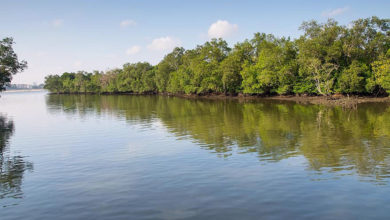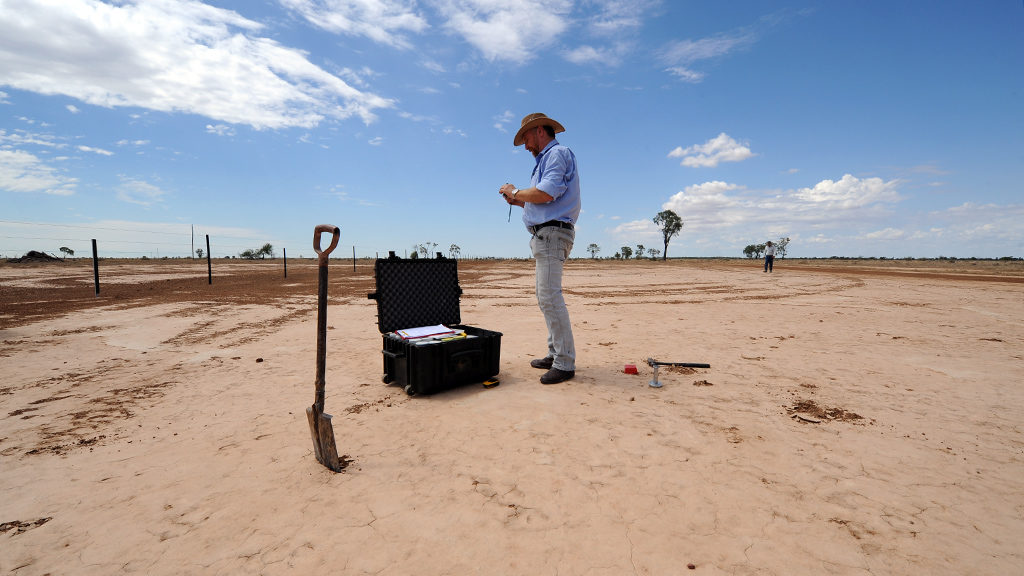
Re-designing farming
The regenerative agriculture revolution promises to dramatically change the way we grow our food. Its success—or failure—could have profound consequences for the future of life on earth.
Ray Thompson is at the wheel of his Hilux driving us north into the saltbush plains between the Macquarie Marshes and the Bogan River in New South Wales. The dash is custom rigged with survey equipment. A laser control unit is mounted above the radio, its instrument panel studded with analogue knobs and switches and bulbous orange and green indicator lights. A baton bolted to the passenger-side floor holds a Terratrip 202—a precise GPS tripmeter used in rally cars that logs and displays interval distances—while overhanging the rear tray of the ute is a two-metre-long ranging pole.
It’s the peak of summer and tufts of grass in the paddocks are golden against the shifting grey clays and red sandy rises. Along creek lines there are V-shaped poplar box and clusters of she-oaks. Most properties here have no permanent water and instead rely on ephemeral channels and soaks that fill after rain. Annual rainfall is around 400mm and when it rains, it’s typically with infrequent large dumps.
Our destination is The Marra, a region on the floodplain about an hour south of Brewarrina where overstocking exposed the soils to wind and water erosion. During the 19th century, millions of acres of luxuriant native grasslands here were transformed into vast, impervious claypans. A government agricultural scientist reported in 1900 that the saltbushes had been “annihilated.” For nearly four decades, Thompson has been regenerating the scalds by designing shallow, u-shaped earthworks that retain rainfall and catch saltbush and grass seeds.
We walk to the edge of the scald where you can see the depth of the erosion. At least 30 cm of loose, sandy loam has washed or blown away. Further along, at a regeneration site, Thompson pulls out a photo of a bare scald. I’m astonished to discover we’re standing in the same location, except now we’re surrounded by saltbush as tall as us. Thompson has regenerated 40,000 hectares like this.
“Read the landscape and design for it,” says Thompson. “That’s what I’ve grown up with.”
This is an unexpected place to find an example of design in agriculture.
***
It is now well established that our dominant agricultural practices are causing planetary-scale ecosystem disruption. Research led by scientists at the University of Queensland and published in the journal Nature found agriculture is a key driver of biodiversity loss and a greater threat to wildlife than climate change. Jonathan Foley described agriculture as “the other inconvenient truth” in a series of articles and talks in 2009, warning that humanity faces “a global crisis in land use and agriculture that could undermine the health, security, and sustainability of our civilization.” In one bleak finding, a recent report by the Food and Land Use Coalition estimated the cost of the damage caused by agriculture is greater than the value of the food produced.
Design professionals are among those rising to the challenge of rethinking current agricultural systems and practices. Dramatic renders of vertical farming structures have captured public interest, rooftop horticultural gardens for new buildings have grown in popularity, and landscape architects have incorporated community agriculture into public places. One proposal for the rebuild of Paris’s Notre Dame cathedral reimagined the roof as a glasshouse, capturing energy to power the building, and using aquaponics and permaculture to grow up to 21 tons of fruits and vegetables per year. Urban agriculture, if done with the right policies and support, could act as a buffer against disruption, reduce food deserts, develop community skills, and increase understanding about how food is produced. But while this is promising, experts still say urban agriculture can likely only supply food for a small proportion of a city’s population, serving as a supplement to broadscale agriculture. This makes the development of more sustainable and regenerative broadscale agriculture systems crucial in the fight against climate change.
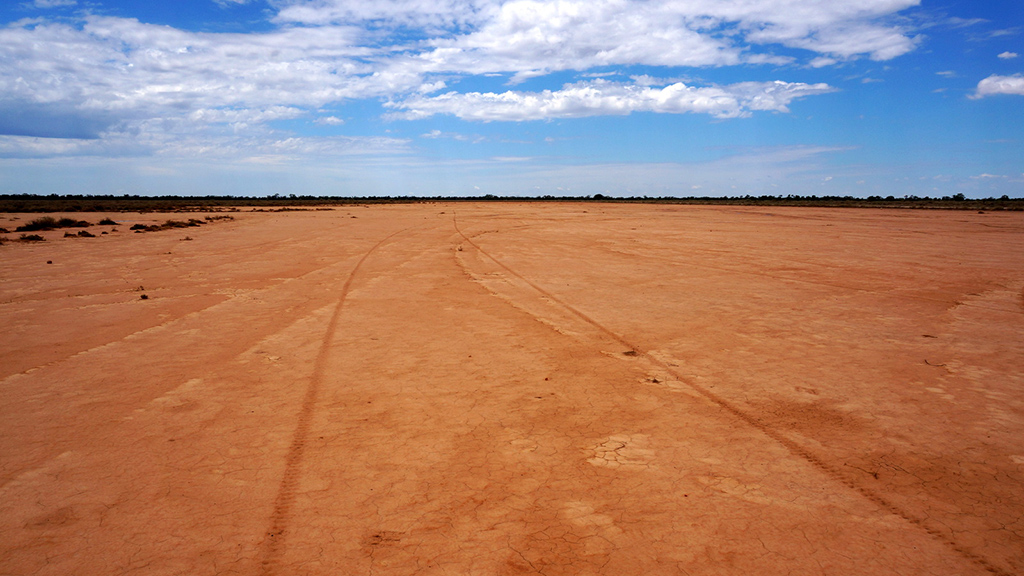
As landscape architect Thomas Woltz asks in a widely viewed TED Talk, “how is it that the way we feed ourselves can end up killing us?” Woltz’s practice Nelson Byrd Woltz has been responsible for several high profile projects in North America and New Zealand that integrate agriculture with landscape architecture to address conservation and sustainability goals. Woltz describes himself as determined to apply the “skillset of landscape architecture to land in need” and the training and interdisciplinary interests of the discipline—in understanding intimate human and large scales, horticulture, landform, drainage, cultural interpretation, and change over time—appear well-suited to collaboration with broadscale agriculture. Yet, despite this, and the seeming success of Woltz’ projects, landscape architecture practice remains rare in agriculture. This is especially surprising in Australia, given its history of developing principles for design in farming, notably keyline planning and permaculture.
In 1954, Australian farmer and inventor PA Yeomans self-published The Keyline Plan, the first of four books explaining techniques and designs to conserve water and improve soil health. Through careful observation, Yeomans developed a holistic understanding of agricultural ecologies, including the importance of soil as a living, evolving system. He showed that farms needed to be planned on a scale that considered the whole of the landscape, taking account of “climate, landscape, water supply, farm roads, trees, permanent buildings, subdivision fences and soil.” He rejected the heavy engineering and high disturbance techniques imported from the US Soil Conservation Service, and instead designed contour plans that responded to natural water courses, slowed the movement of water, retained it in the soil, and spread it towards the ridges rather than to gullies. Tined cultivation, rotational grazing, and mulching fed soil microbes. The design, principles, and methods of Keyline increased biodiversity, resilience, and productivity.
Historian and professor of social ecology, Stuart Hill, believes Yeomans “developed the most innovative, and most sustainable, integrated landscape design and management system that has ever been developed and tested.” Although Keyline design has been taken up by farmers in many countries, it did not break through to the mainstream. Hill attributes this largely to the advent of “deceptively simple management tools” for agriculture that emerged at the same time, such as superphosphate.
Although Keyline’s holistic practices did not gain widespread popularity, as author and farmer Charles Massy writes, it did play a “major role in influencing one of the greatest Australian contributions to a sustainable farming movement: that of permaculture.” David Holmgren, one of the founders of permaculture, drew on Yeoman’s work when developing the concept in the 1970s. Permaculture is embraced by growers around the world and offers significant benefits for sustainability, but like keyline design, it has received little scientific attention and remains limited in its adoption relative to conventional high-input industrial agriculture.
Design opportunities didn’t stop at keyline and permaculture. These holistic alternative agricultural practices emerged at the same time as rising public ecological consciousness. Environmental historian Libby Robin explored how post-war ecological science shaped the values of those who fought to save western Victoria’s Little Desert bushland from new agricultural development. Community members, public servants, and conservation scientists used economic, aesthetic, recreational, and scientific grounds to question the proposal. The 1969 campaign was so successful it became a “cultural icon,” wrote Robin, signalling a transformation in Australian politics and society. News media reported on salinity, rural dieback, land clearing, and erosion. In the wake of this renewed concern for nature, the late 1970s and the 1980s were marked by intense introspection among landholders, rural communities, government managers, scientists, and the wider public over the state of agriculture and its degradation of the environment.
Research, policy, and community responses ensued. The Focus on Farm Trees conference held at the University of Melbourne in 1980 included presentations from scientists, farmers, and the Victorian state government, with a key theme the need to return trees to over-cleared land. Farm tree groups formed in most states, and Greening Australia coalesced as a national organisation dedicated to revegetation. In 1984, the Potter Foundation funded a program to demonstrate it was possible for landholders to ameliorate degraded land, increase productivity, and operate on an environmentally sustainable basis. Fifteen landholders, all from Victoria’s Western District, participated in the Potter Farmland Plan, the largest philanthropic project of its kind at the time. The trial inspired tree plantings in other regions. Amidst an atmosphere of optimism for rural environmental renewal, Rick Farley became instrumental in forming “a most unlikely alliance” between the National Farmers Federation and the Australian Conservation Foundation. In 1989, encouraged by the possibility of consensus, Prime Minister Bob Hawke announced the Decade of Landcare.

Considering the field of landscape architecture established itself and professionalised in Australia over the same period as the development of keyline design, permaculture, and national recognition that farms needed holistic planning for sustainability, one might have expected some crossover. The Australian Institute of Landscape Architects incorporated in 1970 and the journal Landscape Australia launched in 1978. In her honours research, Sky Allen found only one mention of permaculture in the journal’s index from 1979 to 2001 (a book review of Bill Mollison’s Permaculture: A Designers’ Manual).
Landscape architecture and agriculture converged briefly when RMIT’s Jim Sinatra became involved in the Potter Farmland Plan. Sinatra came to Australia from Penn State, having been schooled in the Ian McHarg tradition, a pioneer in the concept of ecological planning. I spoke with Jock Gilbert, a lecturer in Landscape Architecture from RMIT, who told me Sinatra worked with farmers and the Victorian government to ensure landscape architecture was embedded in the Potter Farmland Plan. As far as Jock is aware, forestry, agriculture and landscape architecture haven’t worked on such a scale since in Australia.
“Landscape architecture moved away from the larger scale and towards landscape urbanism,” said Jock.
Curious to learn more about why there is not a stronger relationship between landscape architecture and agriculture in Australia, I spoke with Christie Stewart of Open Wide Agriculture. Six years ago, Stewart had an ambitious and impressive plan to use her skills in landscape architecture to regenerate her family farm in the West Australian wheatbelt. The land was “stuck in a cycle of continuous degeneration” but just as Stewart was about to graduate, the farm became unviable and her family had to sell before she could put the plan into action. She landed a coveted job with the firm UDLA in Freemantle where she tried to pursue her interest in design and agriculture.
“What we what we found was that virtually no farmer was going to pay fifteen grand for a graphic masterplan,” Stewart told me.
Many traditional farmers couldn’t see the value in using their capital to pay for something that wasn’t direct work on the ground. To retain her connection to agriculture, Stewart took a job one day per week working on a tree planting project for start-up company Open Wide Agriculture.
“I was so inspired by what they do and their vision I asked to join full time,” said Stewart.
She is now Farmland Regeneration Coordinator for the start-up’s food brand Dirty Clean Food. The role involves working with beef, lamb and oat suppliers to develop custom farm plans that meet regenerative principles. The plan includes over fifty on-farm practices drawn from literature and certifications from around the world, including maintaining managed biodiversity conservation areas, wildlife movement corridors, pollinator strips, minimising or eliminating synthetic fertiliser usage, high density rotational grazing, multispecies cropping, monitoring of soil, water and nutrient cycles, committing to a learning journey, sharing information, animal welfare, and wage fairness.
“It’s like the regenerative farm plan over my parents’ property but instead of a graphic masterplan it’s dot points with words,” said Stewart.
It’s an adaptation of design principles in a form that’s more affordable for farmers who aren’t ready to engage landscape architects. I asked Stewart what might foster more collaboration between farmers and landscape architecture, given she comes from a broadacre farming background herself. She believes firms interested in this space should improve their skills and knowledge for on-the-ground implementation of designs.
“Knowing how to put semi-permanent fencing together, for example, means you know the logical way it’s going to fit when you go to do the drawing,” said Stewart.
While the cost of engaging a landscape architect might put many farmers off, the more significant barrier is cultural. The kind of holistic agriculture that benefits from design and planning is in the minority. Stewart has heard regenerative growers cop flak at the pub.
“Conventional agriculture is a system that is fully integrated and supported by the big seed suppliers and fertilizer companies. They have the agronomists that tell you which input you need to grow your crop,” said Stewart. “It’s reinforced by your parents, your family, your neighbours. It’s hard to break out of.”
Stewart added that farmer Massy, in his book Call of Reed Warbler (UQP, 2017), “summed it up perfectly when he said the biggest change is the one that happens between your ears.”
***
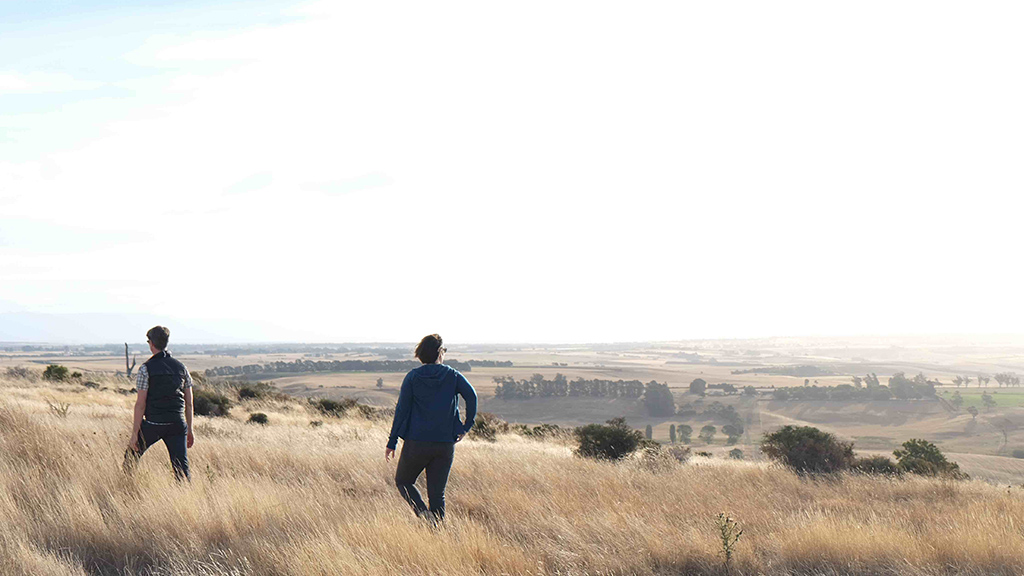
For a few years, I couldn’t face researching and writing about agriculture and the food system. It was too overwhelming. On one field trip after the Millennium Drought, I interviewed two older landholders in western New South Wales and both happened to have adult sons who were expected to take over the farm but had recently committed suicide. The 1980s optimism had evaporated.
Landcare encouraged about a third of Australian farms to become involved in voluntary community groups and was remarkably successful in fostering social connections and teaching the importance of conservation. However, government funding and policy was inadequate for supporting sustainability goals. Researchers calculated that funding amounted to five cents per hectare per year over the duration of the program. A 1999 Industry Commission report described Australia’s ecological sustainable land use policy as “ad hoc, incomplete and tentative.” Despite the interest among some landholders in returning trees to farms, revegetation was limited and isolated. Some labelled the plantings “decoration” or “garnish”. Land restoration practitioners Andrew Campbell, Jason Alexandra, and David Curtis wrote that, “these were often so tiny and scattered to be little benefit at a landscape or ecosystem scale.”
By the 2000s, government funding for sustainable management and regeneration was in decline. In 2009, key independent research body Land and Water Australia was abolished. Clearing regulations were relaxed. The Murray-Darling Basin Plan was plagued by scandal and assessments of mismanagement. In 2017, the Australian public was shocked by ABC’s Four Corners story “Pumped”, which described water theft, meter tampering, unauthorised earthworks, cronyism, and cover-ups. Yet it was nothing new to the conservation scientists, Aboriginal people, policy makers, researchers, and rural communities who had been calling this out for decades.
I knew it was the case with the rivers near where I was raised. I’d read that on the Namoi River in the 1960s, irrigators illegally created scores of ‘straw men’ licence holders to put together thousands of irrigation acres. On the Macquarie River, local NSW Water Conservation and Irrigation officers told landholders how to apply for extra licences by creating companies in the names of family members. In her 1996 book Cottoning On (Hale & Iremonger), journalist and historian Siobhan McHugh interviewed a former Department of Water Resources inspector who feared for his safety in the 1970s when he tried to enforce regulations.
A social media post by the friend of an irrigator, “Pump that river dry. #fukthefrogs”, quoted in the Four Corners story, seemed to encapsulate a recalcitrant farming culture dismissive of science, wildlife, and future generations. Disheartened, I came to believe society was destined to be trapped in an endless loop of ecological degradation as far as agriculture was concerned. That was until I read Call of the Read Warbler.
Over the years I’d read books and been to public seminars about regeneration but thought the odds were stacked against ecological agriculture. The concept appeared fragmented and marginalised and would struggle to attract the scientific research and broader acceptance it required. However, Massy’s storytelling, his synthesis of wide fields of knowledge, and his exhaustive interviewing with hundreds of regenerative farmers, opened my mind to future possibilities. There seemed to be a critical mass of landholders taking a holistic approach—and public reception of the book suggested a renewed mood for change.
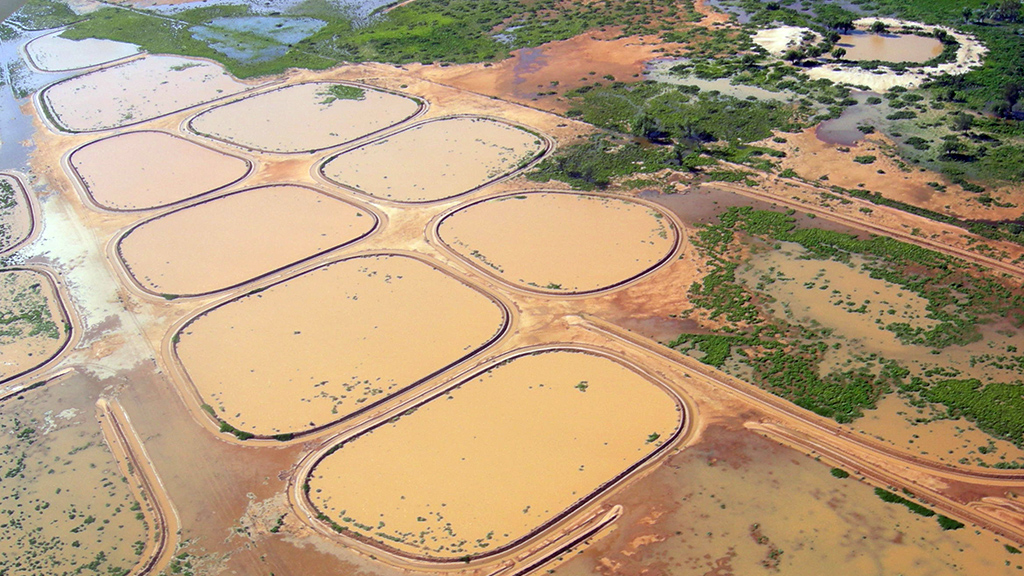
I spoke with Massy recently about the potential for design in agriculture, a matter in which he’s experienced. He designs farm plans for landholders based on regenerative principles, used keyline on his own farm early on, and has advised landscape architects.
Design and regenerative agriculture can make farms more resilient to extreme weather by retaining soil moisture and ground cover for longer. It can also help to mitigate climate change by increasing soil carbon. Last summer’s fires prompted another design adaptation to the disruption unleashed by a warming atmosphere.
“I was working on the design for a property in the Southern Highlands—which people thought was a safe place—but there was a wind change from the south,” said Massy. “These people had never experienced fire before and now there was spotting.”
Massy modified the design to incorporate oak plantings as a fire barrier on critical upslopes and ridge crests where bushfires travel fast.
“When the fire hits the water-laden canopy of the oaks, as opposed to the volatising gases from eucalypts, the fire just drops to the ground within about 20 metres,” said Massy.
On his own property and working for others, Massy has witnessed firsthand the benefits of holistic, carefully planned, designed and managed farms. However, he urges further scientific research is needed to inform landscape design for ecological functioning in agriculture.
“In the space between your vegetation patches there’s a critical distance where insects, birds, and reptiles won’t travel because it’s just too risky, they’re too exposed and vulnerable,” explained Massy. “Pinning down those distances in different Australian environments is important because it informs the principles you can apply for widths of tree breaks; where you put your mosaics, patches and linkages.”
I asked Massy if traditional industrial farmers would be put off by the thought of relinquishing control, leaving their pest management, for example, to birds, insects, and spiders—and whether designing for ecological function would add complexity and uncertainty to decision-making.
“It’s sort of back to front,” said Massy. “Once you simplify through overgrazing and over clearing, it might seem like management will be simpler, but it’s a downward spiral. On the other hand, when you get your ecological management right, you’re enabling self-organizing function again. Then a lot of other things just tend to look after themselves.”
Landscape architecture could offer one means towards integrating agriculture with conservation, and erasing the separation between production and protection. This is the direction Paul Appleton is exploring in his practice. Three years ago, Paul established Nelson Byrd Woltz’s Melbourne field office. He joined the firm in 2013, working on many of the company’s agricultural projects, including Orongo Station in New Zealand. His mentor is Woltz, with whom he shares a deep interest in rural landscapes and regeneration.
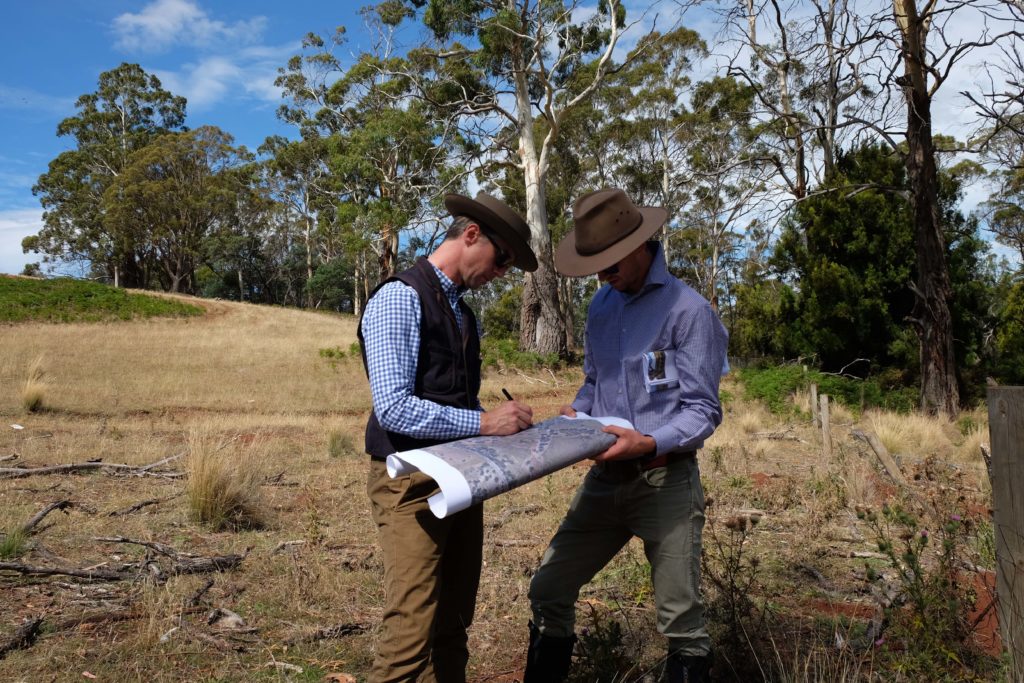
Appleton hails from a farming family and that connection has influenced his affinity for nature and place. It’s also left him with the view that in agriculture, “the status quo is pretty horrendous.” When Appleton read Call of the Reed Warbler, the book made such an impression he invited himself to Massy’s property to see it firsthand.
“Regenerative ag sounded a bit like an infomercial—conserve the biodiversity, fewer inputs, fewer chemicals, better food, better mental health—and I thought, ‘what’s the catch?’”
Since then, he’s been diligently researching regenerative principles, embarking on field trips, attending workshops, and studying courses such as RCS’s Grazing for Profit. He recently opened his own practice, Landscape Workshop, where he aspires to continue with agricultural projects.
When I spoke with Paul he had just finished work on Nelson Byrd Woltz’s first Australian project, at a farm in northern Tasmania. The property had been historically over-cleared of trees and native grasslands. Its owners decided to restore habitat, conserve remnant patches, and increase biodiversity while running a mixed grazing, cropping, and horticulture enterprise that demonstrates best practices for farming without chemicals. It will also include an events and hospitality centre.
“The agriculture needs to support the biodiversity and vice versa,” said Appleton. “And there’s a growing body of evidence that proves one doesn’t have to come at the cost of the other.”
Loss of grasslands in northern Tasmania has reduced pollinator habitat for birds and insects. The design for the property interweaves pollinator habitat across the landscape, by introducing plantings that skirt farm roads and dams. Crops and pastures will benefit from increased pollination. Water bodies will be revegetated with native herbaceous freshwater plants, such as running marsh flower, and white purslane, with its succulent long, thin leaves and profusion of white flowers. The ponds are fringed by tall rushes and sedges. Nesting sites along waterways provide habitat but also prevent erosion, filter run-off from stock pastures, and maintain water temperature.
“We’re under no illusion the people we work for aren’t your typical landholders,” said Appleton. “What we try and do from the outside is use these projects as pioneer projects to test new methods and technologies, new combinations, and then share what we’ve learnt with the region so that more people can benefit.”
Aesthetic and recreational considerations also inform the design. Tree and shrub plantings spill organically from natural contours, while pivot irrigation in cropping areas creates formal circular shapes that become a recurring motif.
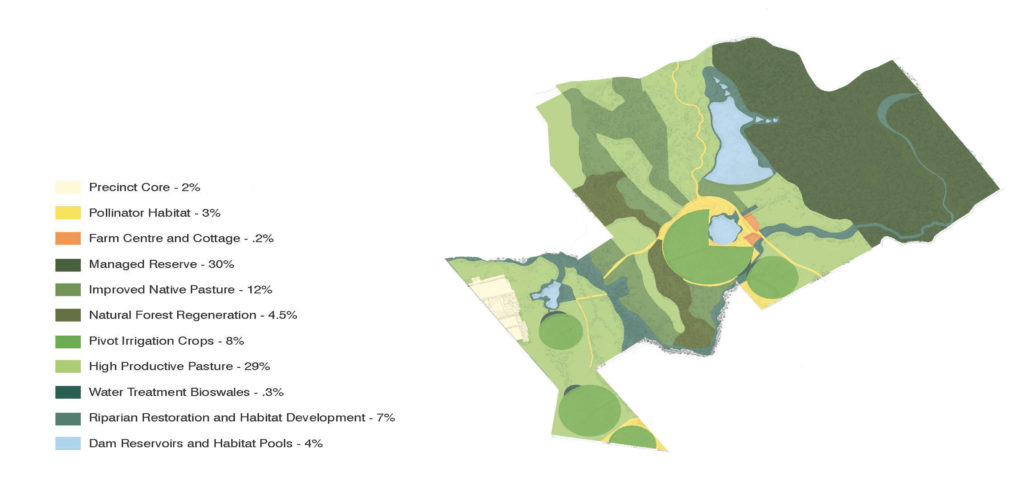
“I think people who are interested in regenerative practices appreciate the land for more than its economic potential,” said Appleton. “Assisting the property to be productive and beautiful with design will enhance their appreciation.”
The master plan includes provision for hollow breeding trees, projecting hundreds of years into the future: a hollow suitable for masked owls takes up to 220 years to develop.
Landscape architecture can’t solve all of the fraught challenges facing farming, but it could play a valuable role in guiding design and planning for holistic, regenerative broadscale agriculture. It could assist landholders and managers in efforts to return ecological integrity to agricultural landscapes and allow vast areas of damaged, degraded land to flourish. In Stewart’s view, deemphasising machinery and technology and focusing instead on working with natural biological processes, multidisciplinary design, and holistic connections between health, food and farming, could elevate women’s voices and expertise in agriculture.
For design and landscape architecture to gain more traction in broadscale agriculture, however, a significant cultural shift in farming would need to occur—from simplification and uniformity to the kind of holistic, ecological agriculture that would benefit most from design and planning. Had the early policies and programs for ecologically sustainable land management been consistent and offered sufficient support, more landholders may have sought professionals to design integrated, biodiverse, landscape-scale farm plans. Farmers pay for advice they value.
When I met first met Ray Thompson, the single-handed driving force behind water ponding for regeneration, I was amazed at what he had achieved. But for years I viewed his work as an isolated example dependent entirely on the commitment of one individual. After speaking to Thompson recently I’ve come to see it differently.
“One fella up here watched from ‘85 until ‘94,” said Thompson, of one landholder’s reluctance to try water ponding to regenerate his scalded land. “He just sat on the fence and watched everybody.”
Now that landholder has covered every inch of his property with ponds.
“He just can’t put enough on,” said Thompson.
Thompson has been designing ponds in the Kimberly and Queensland. He’s taught the principles in countries in Africa. The last few years of drought pushed more landholders on the scalded rangelands to try designing for regeneration—those with the ponds had groundcover, those without have bare claypans. Demand is so high there’s a year-long waiting list.
Now I see Ray Thompson as part of a scattered group of tenacious innovators: individuals such as Peter Andrews, John Fenton and others who were part of the trees on farms movement of the 1980s; Charles Massy and the regenerative farmers in his book; Christie Stewart and her landscape design adapted to words; Paul Appleton trying to broaden the image of landscape architecture as a practice that has applications for largescale agriculture and conservation. They are demonstrating by example the benefit of design in agriculture and contributing to the cultural shift.
“These days everything up here is designed to the landscape,” Thompson told me. “Nobody is building anything that’s not designed.”
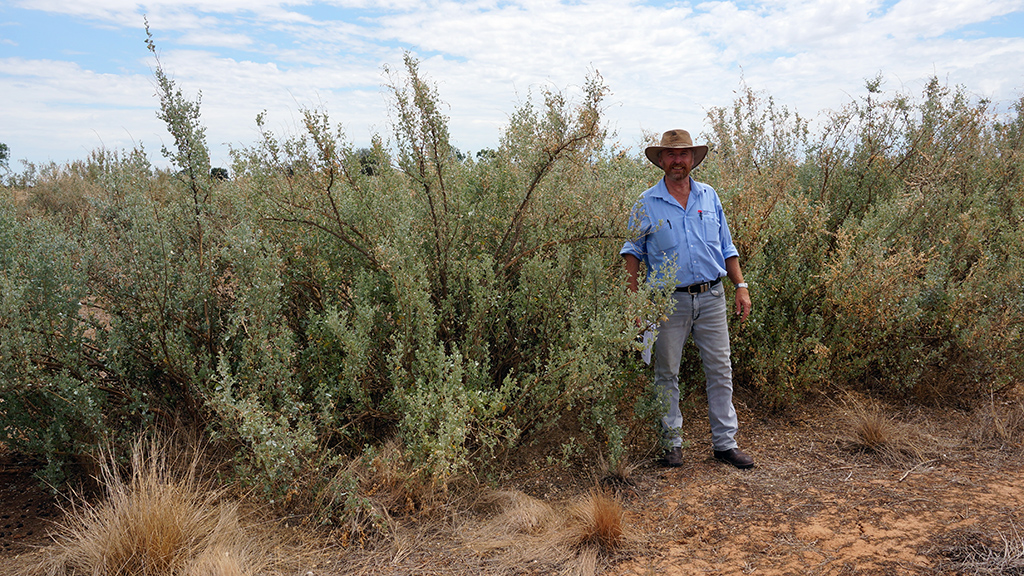
Cameron Muir is a freelance writer, editor and researcher. His work has appeared in Griffith Review, Meanjin, Inside Story, Overland, The Guardian, Australian Book Review, The Canberra Times, and Best Australian Science Writing, among other publications. His book The Broken Promise of Agricultural Progress: An Environmental History was published in 2014 by Routledge and he is a co-editor of the recent book Living with the Anthropocene: Love, loss and hope in the face of environmental crisis (NewSouth, 2020).


